Study on the Mechanism of Burr Formation by Simulation and Experiment in Ultrasonic Vibration-Assisted Micromilling
Abstract
1. Introduction
2. Simulation and Experiment
2.1. Simulation Method
2.2. Experimental Method
3. Results and Discussion
3.1. Chip Formation
3.2. Trajectory Equation of Cutting Edge
3.3. Simulation and Experiment Results
3.3.1. Trajectory of Cutting Edge
3.3.2. Cutting Force and Cutting Temperature
3.3.3. Equivalent Strain Analysis
3.3.4. Burr Formation
4. Conclusions
Author Contributions
Funding
Institutional Review Board Statement
Informed Consent Statement
Data Availability Statement
Conflicts of Interest
References
- Bücker, M.; Bartolomeis, A.D.; Oezkaya, E.; Shokrani, A.; Biermann, D. Experimental and computational investigations on the effects of deep-temperature emulsion on the turning of Inconel 718 alloy. CIRP J. Manuf. Sci. Technol. 2020, 31, 48–60. [Google Scholar] [CrossRef]
- Sun, Z.; To, S.; Zhang, S.; Zhang, G. Theoretical and experimental investigation into non-uniformity of surface generation in micro-milling. Int. J. Mech. Sci. 2018, 140, 313–324. [Google Scholar] [CrossRef]
- Muhammad, A.; Gupta, M.K.; Mikołajczyk, T.; Pimenov, D.Y.; Giasin, K. Effect of Tool Coating and Cutting Parameters on Surface Roughness and Burr Formation during Micromilling of Inconel 718. Metals 2021, 11, 167. [Google Scholar] [CrossRef]
- Câmara, M.A.; Rubio, J.C.; Abrão, A.M.; Davim, J.P. State of the Art on Micromilling of Materials, a Review. J. Mater. Sci. Technol. 2012, 28, 673–685. [Google Scholar] [CrossRef]
- Biermann, D.; Hartmann, H. Reduction of Burr Formation in Drilling Using Cryogenic Process Cooling. Procedia CIRP 2012, 3, 85–90. [Google Scholar] [CrossRef]
- Hashimura, M.; Hassamontr, J.; Dornfeld, D.A. Effect of In-Plane Exit Angle and Rake Angles on Burr Height and Thickness in Face Milling Operation. J. Manuf. Sci. Eng. 1999, 121, 13–19. [Google Scholar] [CrossRef]
- Pang, X.; Zeng, Y.; Zhang, J.; Deng, W. Analytical model and experimental verification of Poisson burr formation in ductile metal machining. J. Mater. Process. Technol. 2021, 290, 116966. [Google Scholar] [CrossRef]
- Hajiahmadi, S. Burr size investigation in micro milling of stainless steel 316L. Int. J. Light. Mater. Manuf. 2019, 2, 296–304. [Google Scholar] [CrossRef]
- Aslantas, K.; Ekici, E.; Çiçek, A. Optimization of process parameters for micro milling of Ti-6Al-4V alloy using Taguchi-based gray relational analysis. Measurement 2018, 128, 419–427. [Google Scholar] [CrossRef]
- Kobayashi, R.; Xu, S.; Shimada, K.; Mizutani, M.; Kuriyagawa, T. Defining the effects of cutting parameters on burr formation and minimization in ultra-precision grooving of amorphous alloy. Precis. Eng. 2017, 49, 115–121. [Google Scholar] [CrossRef]
- Saptaji, K.; Subbiah, S. Burr Reduction of Micro-milled Microfluidic Channels Mould Using a Tapered Tool. Procedia Eng. 2017, 184, 137–144. [Google Scholar] [CrossRef]
- Li, S.S.; Zou, B.; Xu, K.; Wang, Y.S. Machined channel quality and tool life using cermet micro-mill in micro-milling aluminum alloy. Int. J. Adv. Manuf. Technol. 2019, 101, 2205–2216. [Google Scholar] [CrossRef]
- Xu, J.; Feng, P.; Feng, F.; Zha, H.; Liang, G. Subsurface damage and burr improvements of aramid fiber reinforced plastics by using longitudinal–torsional ultrasonic vibration milling. J. Mater. Process. Technol. 2021, 297, 117265. [Google Scholar] [CrossRef]
- Xiang, D.-H.; Wu, B.-F.; Yao, Y.-L.; Zhao, B.; Tang, J.-Y. Ultrasonic Vibration Assisted Cutting of Nomex Honeycomb Core Materials. Int. J. Precis. Eng. Manuf. 2019, 20, 27–36. [Google Scholar] [CrossRef]
- Giraldo, M.M.; Martínez, D.S.; Bolívar, J.A.P.; Cabrera, J.L.B. Burr formation and control for polymers micro-milling: A case study with vortex tube cooling. Dyna 2017, 84, 150–159. [Google Scholar] [CrossRef]
- Sreenivasulu, R.; SrinivasaRao, C. Modelling, Simulation and Experimental validation of Burr size in Drilling of Aluminium 6061 alloy. Procedia Manuf. 2018, 20, 458–463. [Google Scholar] [CrossRef]
- Meng, Q.; Cai, J.; Cheng, H.; Zhang, K. Investigation of CFRP cutting mechanism variation and the induced effects on cutting response and damage distribution. Int. J. Adv. Manuf. Technol. 2020, 106, 2893–2907. [Google Scholar] [CrossRef]
- Yadav, A.; Kumar, M.; Bajpai, V.; Singh, N.K.; Singh, R.K. FE modeling of burr size in high- speed micro-milling of Ti6Al4V. Precis. Eng. 2017, 49, 287–292. [Google Scholar] [CrossRef]
- Zou, Z.; Liu, L.; Li, B.; Deng, W. Research on burr formation mechanism in metal cutting with a backup material. Int. J. Adv. Manuf. Technol. 2016, 86, 1895–1907. [Google Scholar] [CrossRef]
- Asad, M. Effects of Tool Edge Geometry on Chip Segmentation and Exit Burr: A Finite Element Approach. Metals 2019, 9, 1234. [Google Scholar] [CrossRef]
- Sreenivasulu, R.; Rao, C.S. Some Investigations on Drilling of Aluminium Alloy from FEA-Based Simulation Using DEFORM-3D. In Advances in Simulation, Product Design and Development; Springer Nature: Singapore, 2020; pp. 3–15. [Google Scholar] [CrossRef]
- An, Q.L.; Dang, J.Q.; Liu, G.Y.; Dong, D.P.; Ming, W.W.; Chen, M. A new method for deburring of servo valve core edge based on ultraprecision cutting with the designed monocrystalline diamond tool. Sci. China Technol. Sci. 2019, 62, 1805–1815. [Google Scholar] [CrossRef]
- Chen, W.; Teng, X.; Zheng, L.; Xie, W.; Huo, D. Burr reduction mechanism in vibration-assisted micro milling. Manuf. Lett. 2018, 16, 6–9. [Google Scholar] [CrossRef]
- Chen, L.; Deng, D.; Pi, G.; Huang, X.; Zhou, W. Burr formation and surface roughness characteristics in micro-milling of microchannels. Int. J. Adv. Manuf. Technol. 2020, 111, 1277–1290. [Google Scholar] [CrossRef]
- Chen, W.; Zheng, L.; Teng, X.; Yang, K.; Huo, D. Finite element simulation and experimental investigation on cutting mechanism in vibration-assisted micro-milling. Int. J. Adv. Manuf. Technol. 2019, 105, 4539–4549. [Google Scholar] [CrossRef]
- Le, D.; Lee, J.-M.; Kim, S.-J.; Lee, D.-Y.; Lee, S.-W. Burr analysis in microgrooving. Int. J. Adv. Manuf. Technol. 2010, 50, 569–577. [Google Scholar] [CrossRef]
- Wu, F.; Liu, Z.; Guo, B.; Sun, Y.; Chen, J. Research on the burr-free interrupted cutting model of metals. J. Mater. Process. Technol. 2021, 295, 117190. [Google Scholar] [CrossRef]
- Efstathiou, C.; Vakondios, D.; Lyronis, A.; Sofiakis, K.; Antoniadis, A. Finite Element Modeling and Experimental Study of Burr Formation in Drilling Processes. In Proceedings of the ASME 2016 International Mechanical Engineering Congress and Exposition, Phoenix, AZ, USA, 11–17 November 2016. [Google Scholar]
- Yu, L.; Guo, C.; Ranganath, S.; Talarico, R.A. Multi-phase FE model for machining Inconel 718. In Proceedings of the ASME 2010 International Manufacturing Science and Engineering Conference, Erie, PA, USA, 12–15 October 2010; pp. 263–269. [Google Scholar]
- Xie, W.; Wang, X.; Liu, E.; Wang, J.; Tang, X.; Li, G.; Zhang, J.; Yang, L.; Chai, Y.; Zhao, B. Research on cutting force and surface integrity of TC18 titanium alloy by longitudinal ultrasonic vibration assisted milling. Int. J. Adv. Manuf. Technol. 2022, 119, 4745–4755. [Google Scholar] [CrossRef]
- Zhang, Z.; Yuan, Z.; Wang, G. Formation and Control Technology of Top Burr in Micro-Milling. MATEC Web Conf. 2017, 108, 4003. [Google Scholar] [CrossRef]

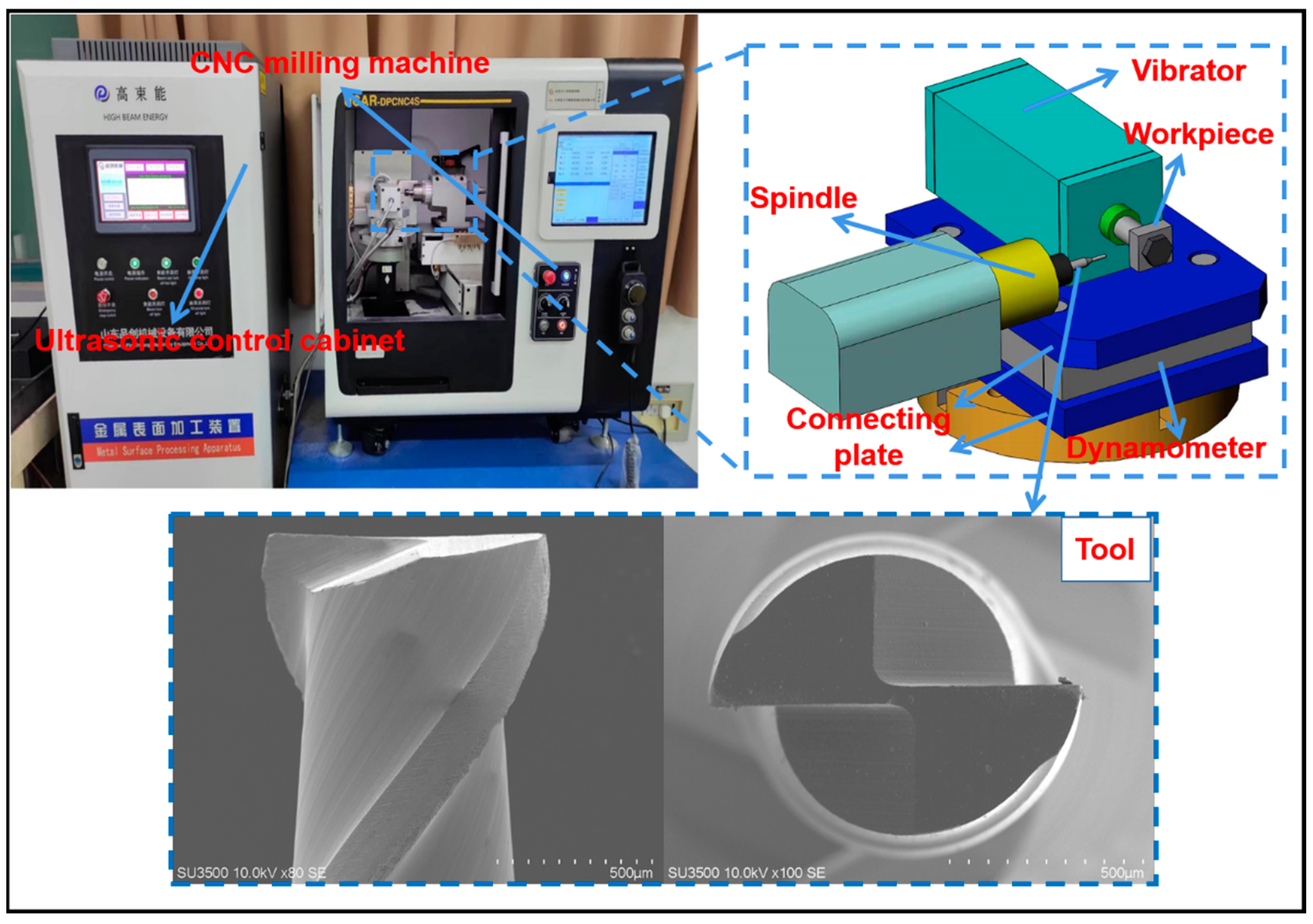
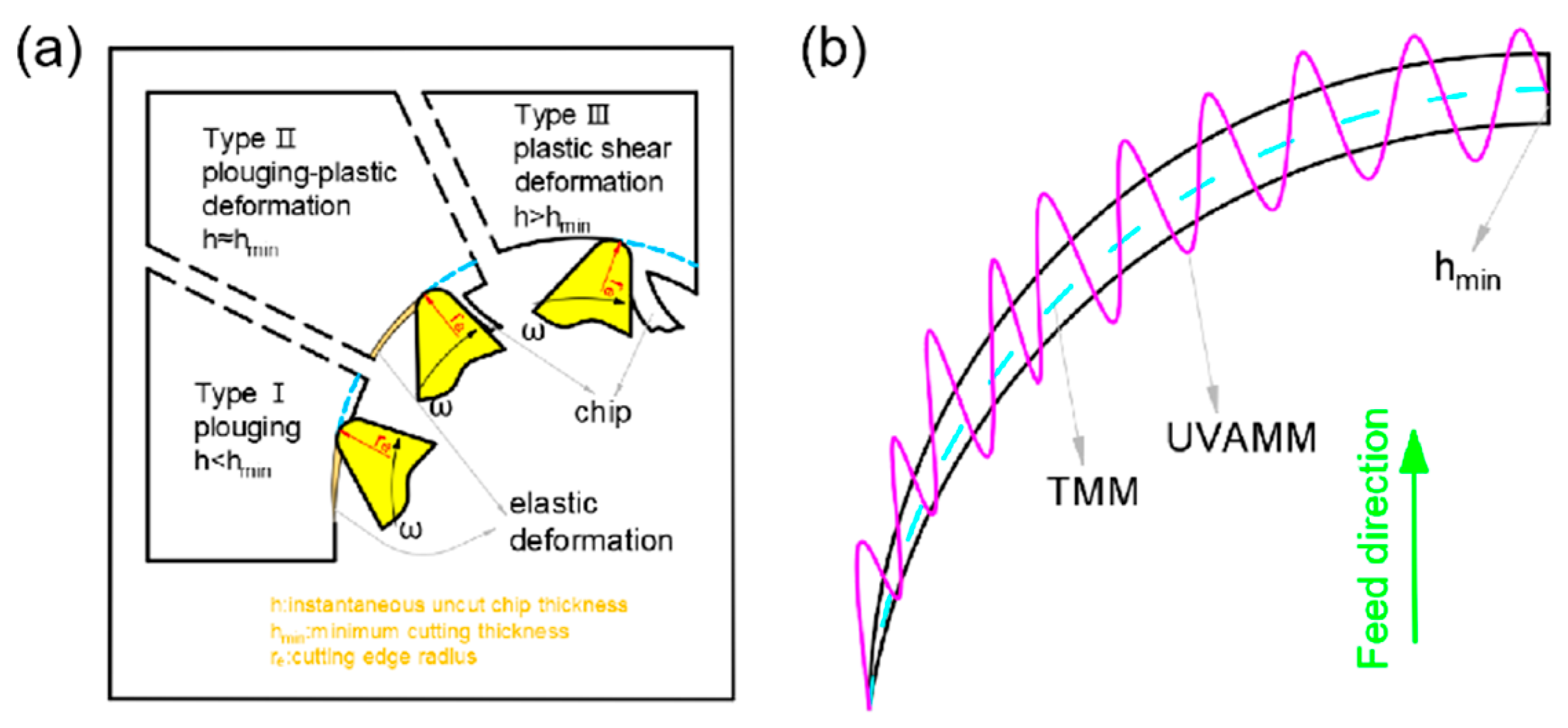
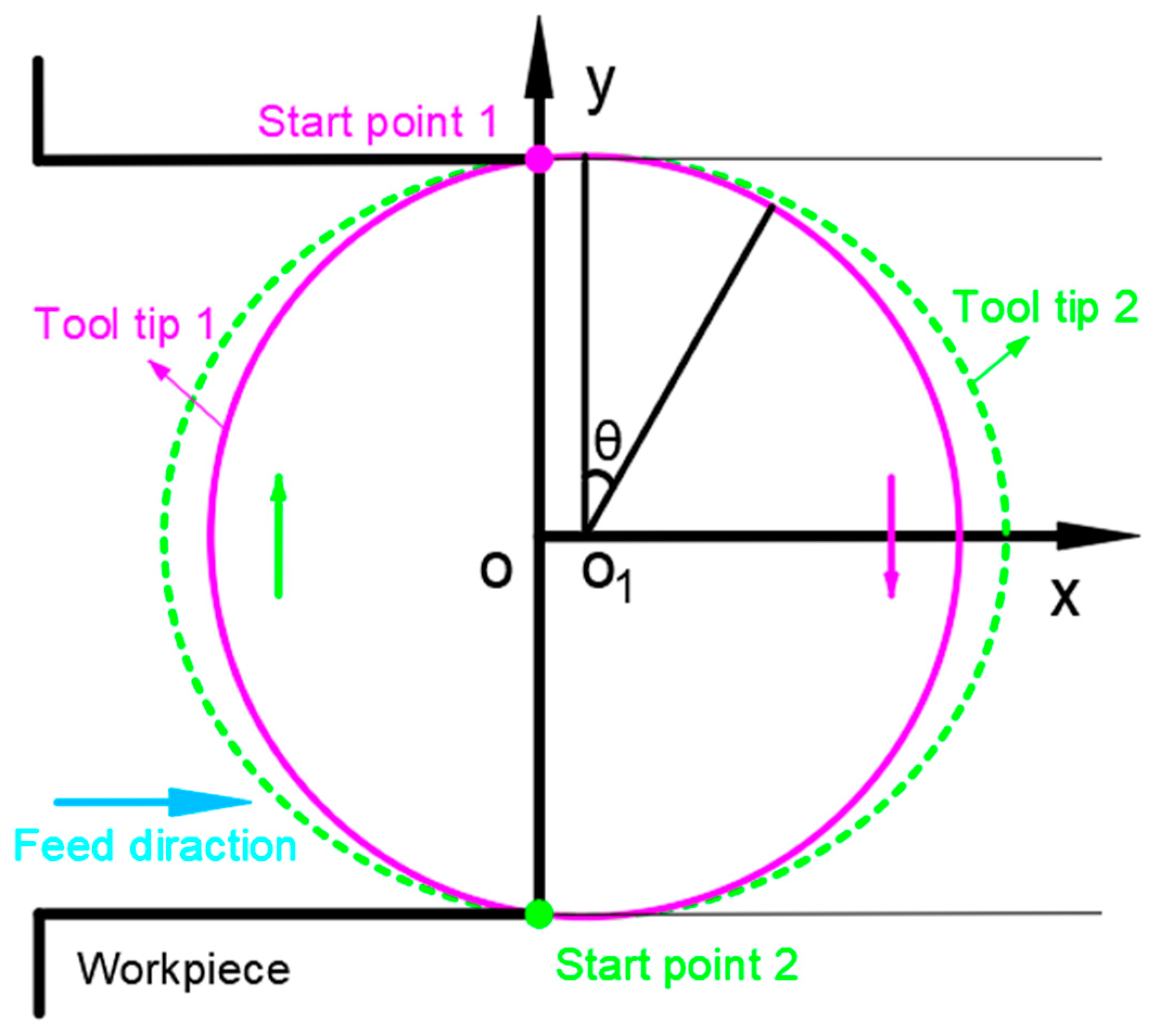


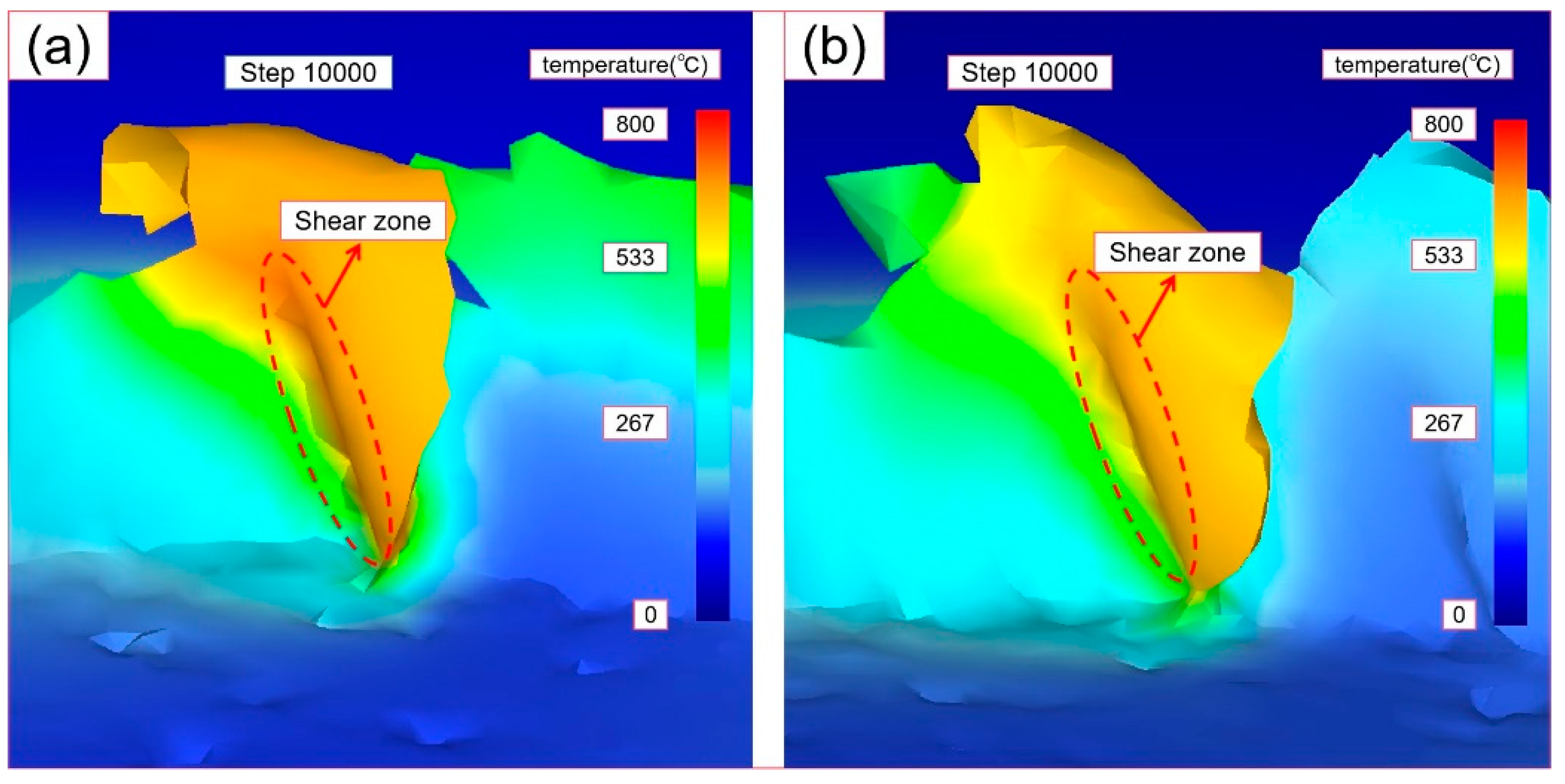
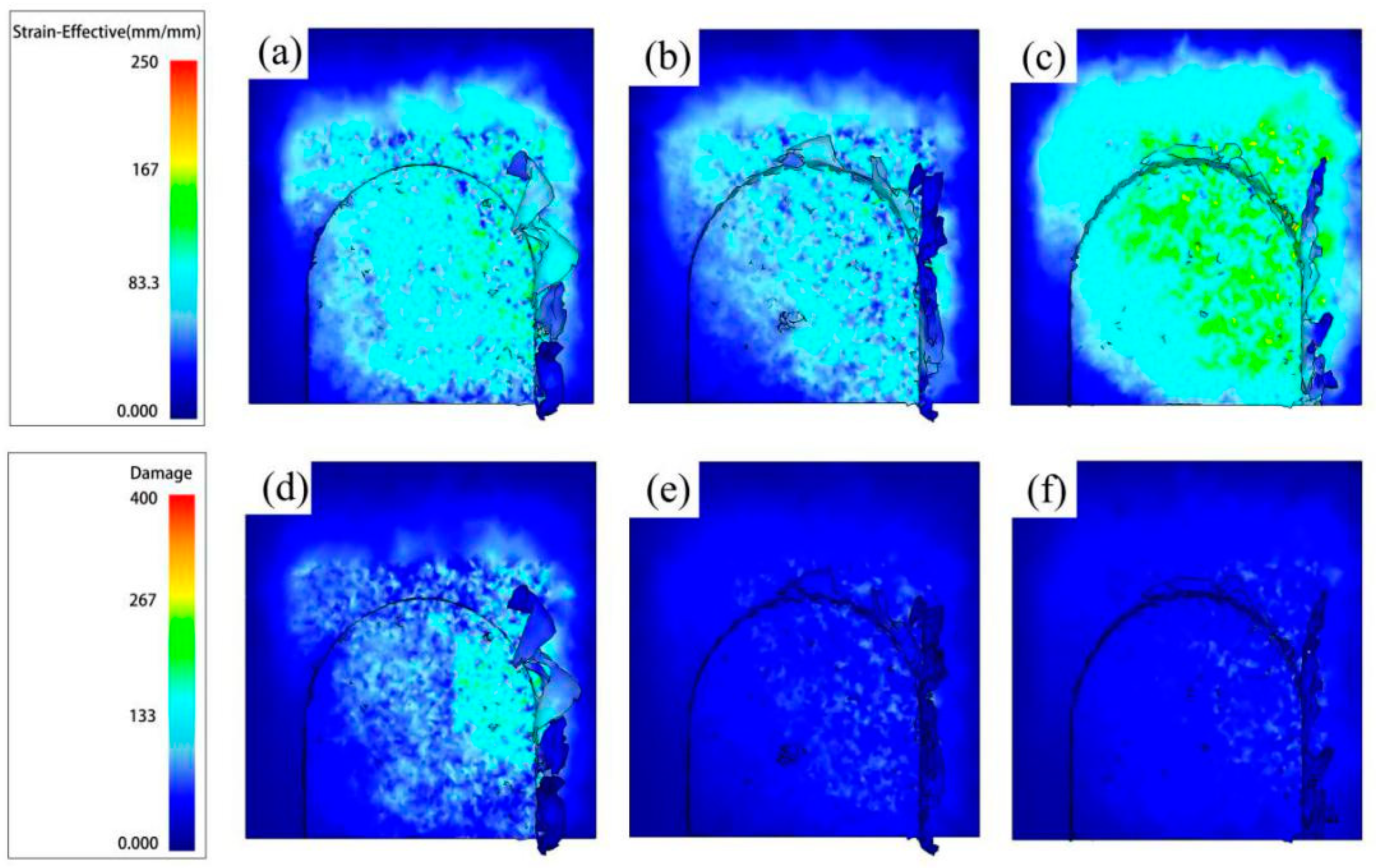
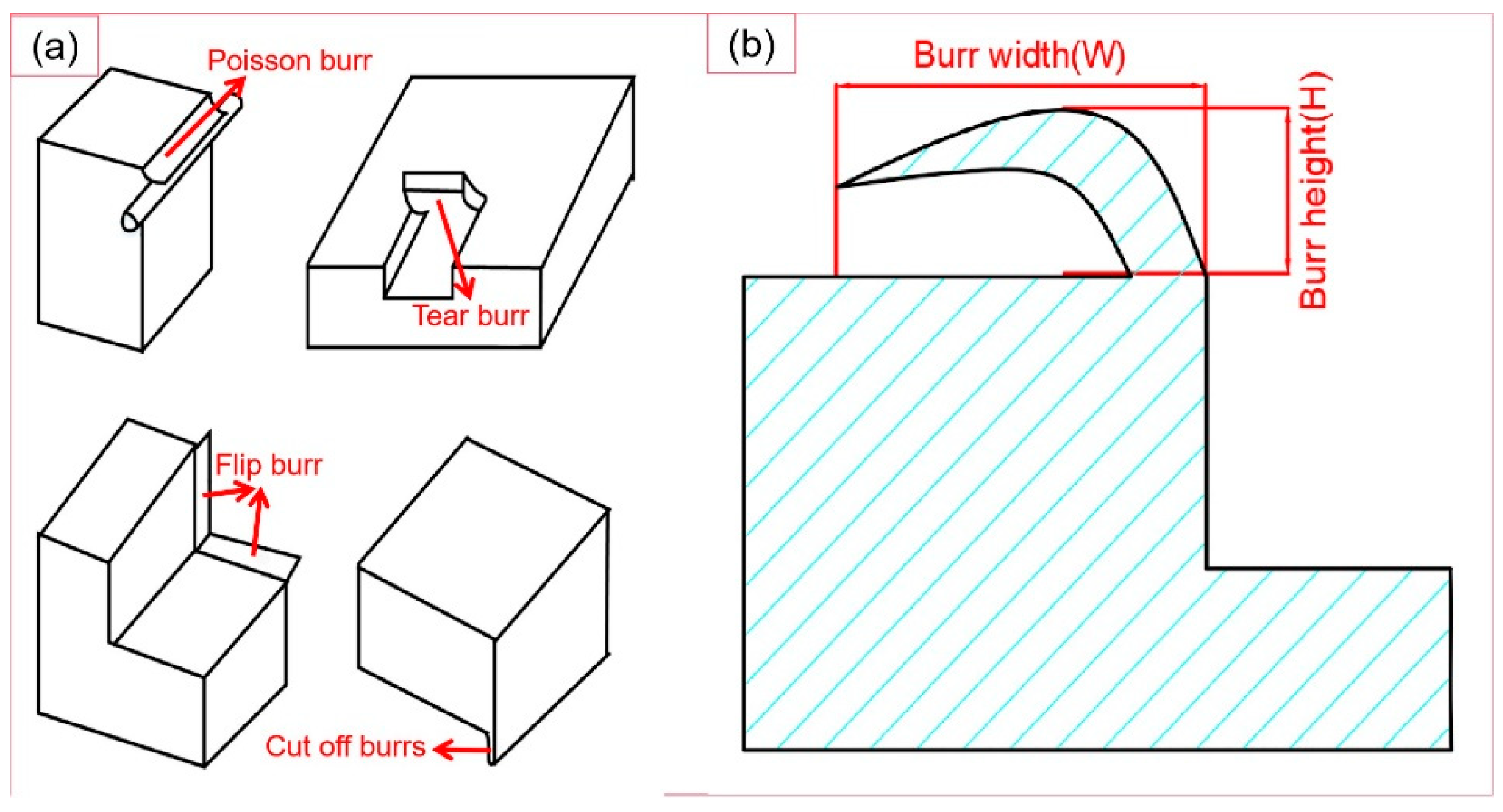
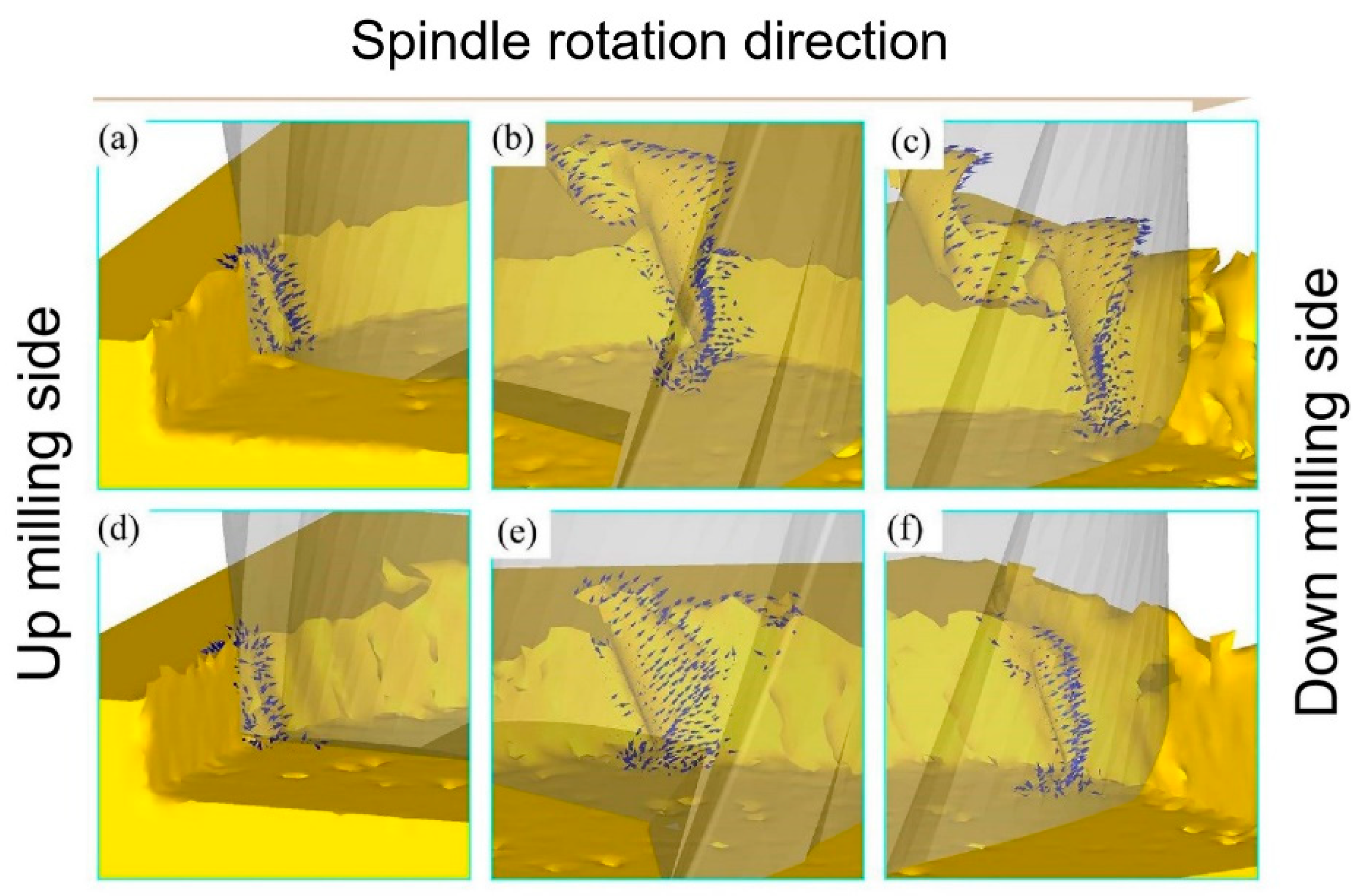

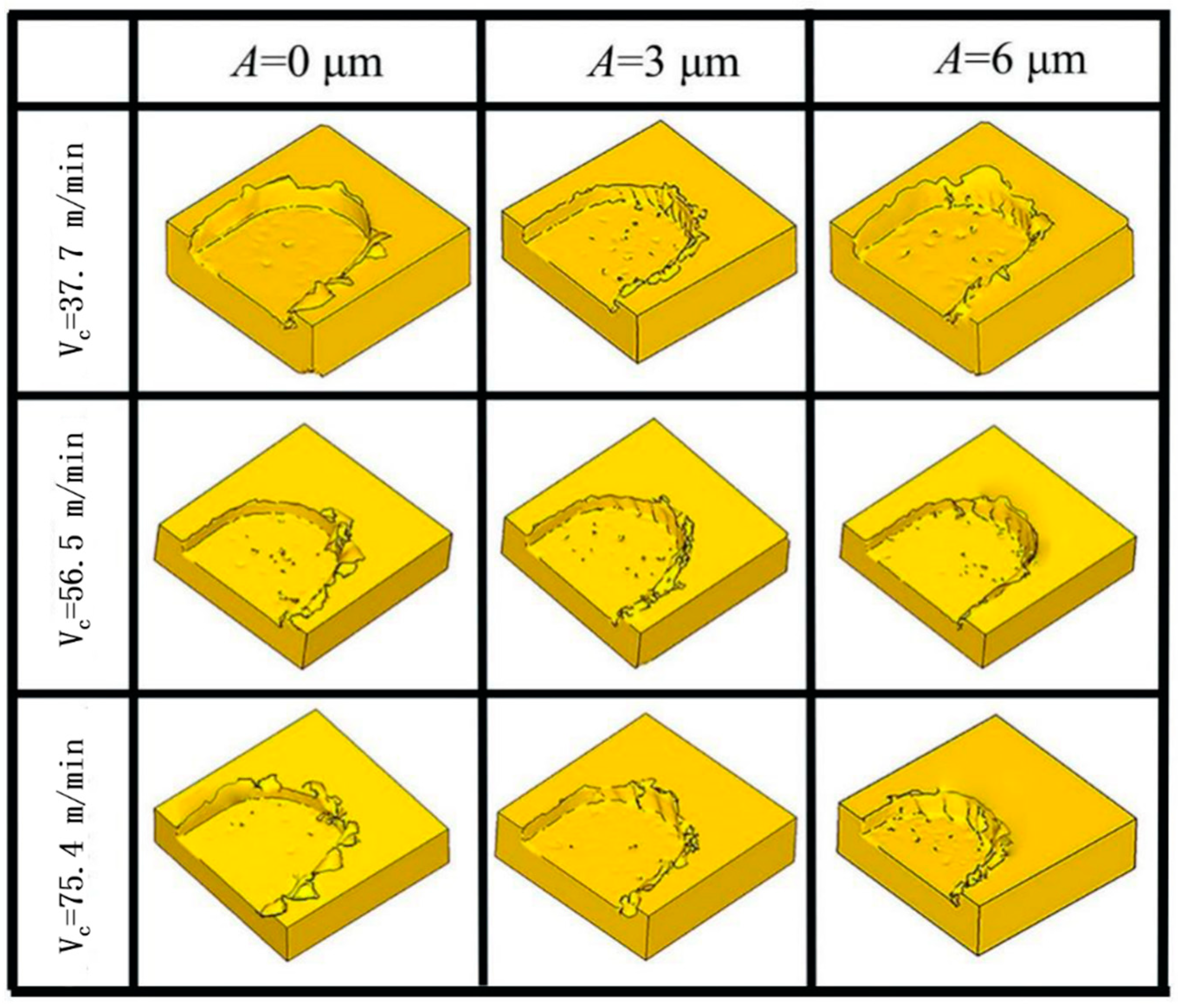

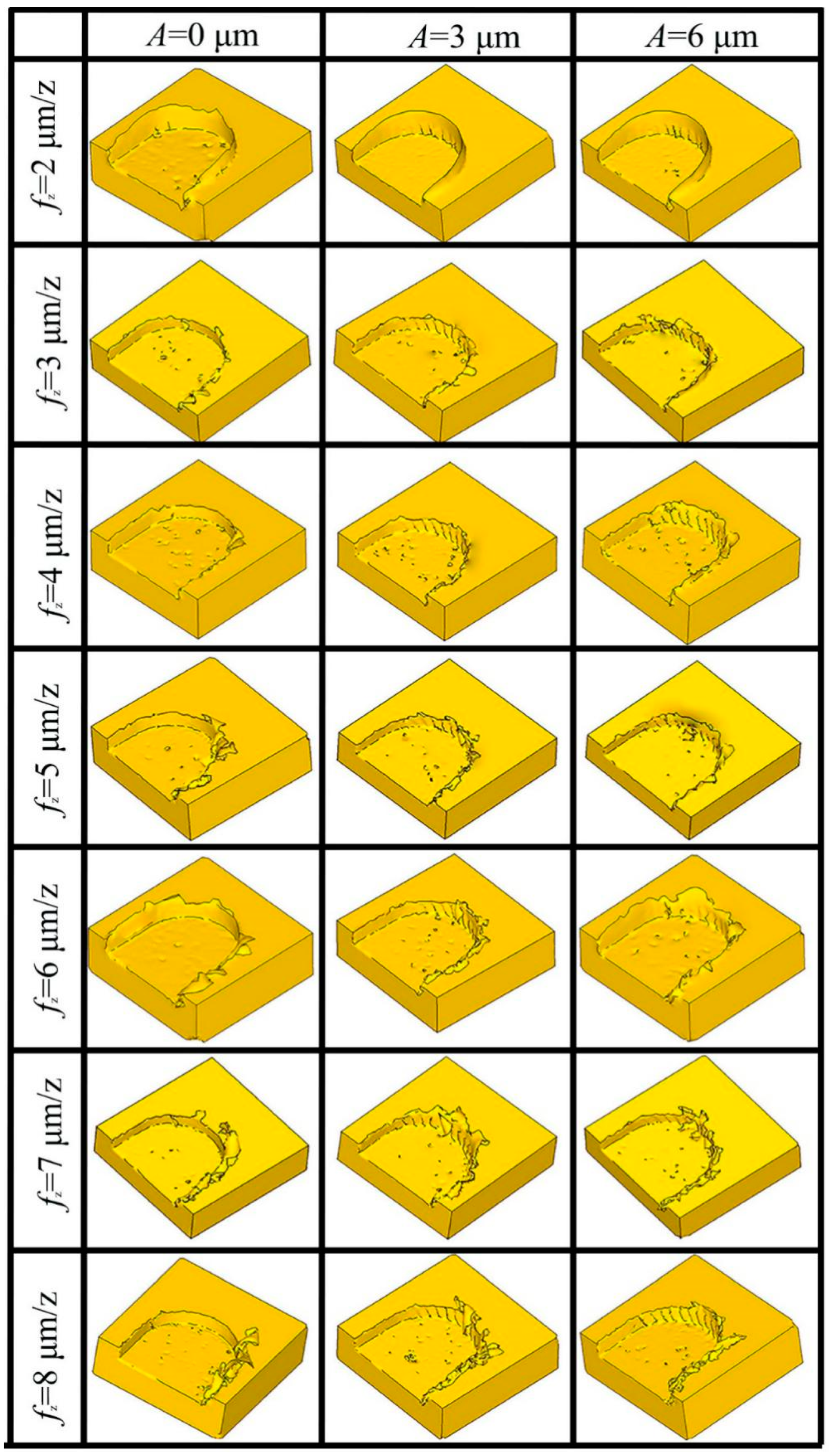
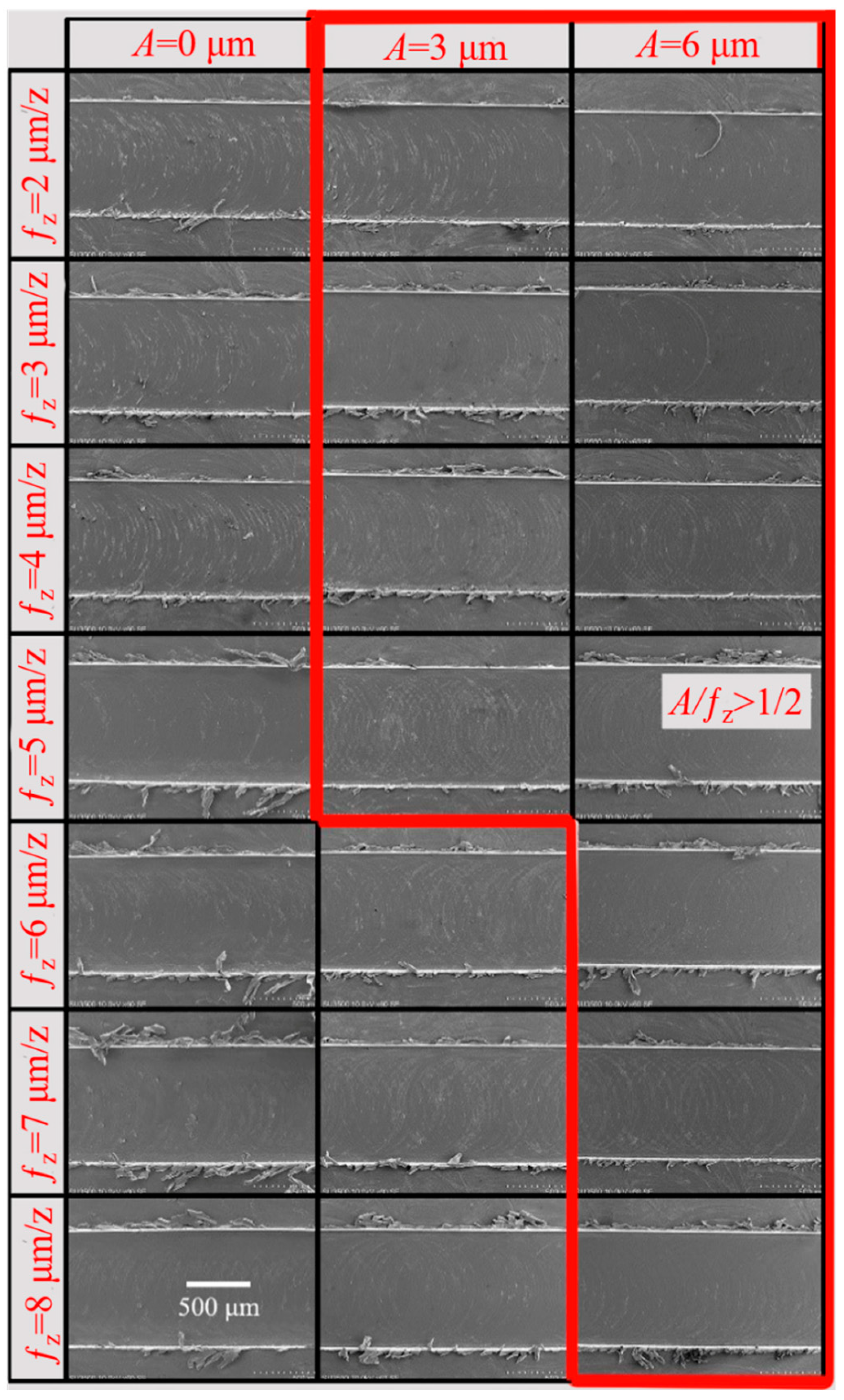
| Geometrical Characteristic | Tool Diameter (mm) | Blade Length (mm) | Cutting Edge Radius (μm) | Helical Angle (°) |
|---|---|---|---|---|
| Parameter value | 0.2 | 4 | 5 | 36 |
| Geometrical characteristic | Rake angle of side edge (°) | Rear angle of side edge (°) | First rear angle of base edge (°) | Second rear angle of base edge (°) |
| Parameter value | 0 | 9 | 9 | 16 |
| Experiment Number | Cutting Speed vc (m/min) | Cutting Depth ap (μm) | Feed per Tooth ƒz (μm/z) | Amplitude A (μm) | Vibration Frequency ƒ (kHz) |
|---|---|---|---|---|---|
| Simulation 1 | 37.7 56.5 75.4 | 50 | 6 | 0 3 6 | 32 |
| Simulation 2 | 37.7 | 50 | 2 3 4 5 6 7 8 | 0 3 6 | 32 |
| Geometrical Characteristic | Tool Diameter (mm) | Blade Length (mm) | Cutting Edge Radius (μm) | Helical Angle (°) |
|---|---|---|---|---|
| Parameter value | 1 | 4 | 5 | 36 |
| Geometrical characteristic | Rake angle of side edge (°) | Rear angle of side edge (°) | First rear angle of base edge (°) | Second rear angle of base edge (°) |
| Parameter value | 0 | 9 | 9 | 16 |
| Element | Ni | Cr | Fe | Nb | S | Ti |
|---|---|---|---|---|---|---|
| wt% | 55.54 | 18.77 | 18.17 | 4.78 | 1.67 | 1.07 |
| Experiment Number | Cutting Speed vc (m/min) | Cutting Depth ap (μm) | Feed per Tooth ƒz (μm/z) | Amplitude A (μm) | Vibration Frequency ƒ (kHz) |
|---|---|---|---|---|---|
| Experiment 1 | 37.7 56.5 75.4 | 50 | 6 | 0 3 6 | 32 |
| Experiment 2 | 37.7 | 50 | 2 3 4 5 6 7 8 | 0 3 6 | 32 |
Disclaimer/Publisher’s Note: The statements, opinions and data contained in all publications are solely those of the individual author(s) and contributor(s) and not of MDPI and/or the editor(s). MDPI and/or the editor(s) disclaim responsibility for any injury to people or property resulting from any ideas, methods, instructions or products referred to in the content. |
© 2023 by the authors. Licensee MDPI, Basel, Switzerland. This article is an open access article distributed under the terms and conditions of the Creative Commons Attribution (CC BY) license (https://creativecommons.org/licenses/by/4.0/).
Share and Cite
Zhang, Y.; Yuan, Z.; Fang, B.; Gao, L.; Chen, Z.; Su, G. Study on the Mechanism of Burr Formation by Simulation and Experiment in Ultrasonic Vibration-Assisted Micromilling. Micromachines 2023, 14, 625. https://doi.org/10.3390/mi14030625
Zhang Y, Yuan Z, Fang B, Gao L, Chen Z, Su G. Study on the Mechanism of Burr Formation by Simulation and Experiment in Ultrasonic Vibration-Assisted Micromilling. Micromachines. 2023; 14(3):625. https://doi.org/10.3390/mi14030625
Chicago/Turabian StyleZhang, Yuanbin, Zhonghang Yuan, Bin Fang, Liying Gao, Zhiyuan Chen, and Guosheng Su. 2023. "Study on the Mechanism of Burr Formation by Simulation and Experiment in Ultrasonic Vibration-Assisted Micromilling" Micromachines 14, no. 3: 625. https://doi.org/10.3390/mi14030625
APA StyleZhang, Y., Yuan, Z., Fang, B., Gao, L., Chen, Z., & Su, G. (2023). Study on the Mechanism of Burr Formation by Simulation and Experiment in Ultrasonic Vibration-Assisted Micromilling. Micromachines, 14(3), 625. https://doi.org/10.3390/mi14030625







